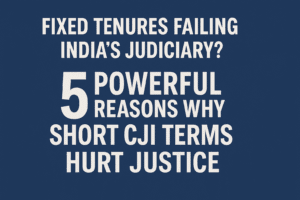Fixed Tenures Failing India’s Judiciary? 5 Powerful Reasons Why Short CJI Terms Hurt Justice
India’s Chief Justices, tasked with leading the world’s largest judiciary, increasingly face abbreviated tenures—Justice Gavai’s six-month term and Justice Nagarathna’s upcoming 36-day stint exemplify a systemic flaw. While the Constitution safeguards judicial independence, its framers overlooked fixed tenures, assuming seniority-based appointments would ensure stability. Today, transient leadership stifles reforms: complex initiatives like digitizing courts or reducing case backlogs demand continuity, yet frequent transitions derail progress.
Globally, models like the U.S. lifetime tenure or Germany’s 12-year terms emphasize sustained vision, contrasting India’s ad-hoc approach. Critics argue fixed terms risk complacency, but a balanced 3-5 year tenure could empower CJIs to enact meaningful change while ensuring accountability. With 4.9 crore pending cases, India’s judiciary needs stability, not stopgap leadership. Parliament must prioritize amending Article 124—transforming convention into constitutional clarity—to empower CJIs as catalysts, not caretakers, of justice.

Fixed Tenures Failing India’s Judiciary? 5 Powerful Reasons Why Short CJI Terms Hurt Justice
The recent swearing-in of Justice Bhushan Ramakrishna Gavai as India’s 50th Chief Justice (CJI) highlights a growing concern: his six-month tenure, ending November 2025, follows similarly brief terms like Justice Sanjiv Khanna’s six months and Justice UU Lalit’s 74 days. With future CJIs, including Justice BV Nagarathna, slated for mere 36 days in office, the question arises—can such fleeting leadership effectively steer the world’s largest judiciary?
The Problem of Ephemeral Leadership
India’s CJI, while termed “first among equals,” wields unique influence as the judiciary’s administrative head and “Master of the Roster.” Short tenures, however, cripple their ability to drive systemic reforms. Consider Justice DY Chandrachud’s two-year term (2022–2024), during which he advanced digital infrastructure and presided over landmark Constitution Bench rulings. Contrast this with Justice Lalit’s 74-day tenure, which allowed only limited progress on his priority of streamlining case listings. Such disparities underscore how tenure length directly impacts judicial outcomes.
Historical Oversight in the Constitution
The Constituent Assembly meticulously debated judicial independence but overlooked fixed tenures for CJIs. Dr. B.R. Ambedkar and peers focused on insulating judges from political interference, mandating retirement at 65 (Article 124). The seniority-based appointment system, a convention rather than constitutional mandate, assumed CJIs would serve substantial terms. However, delayed elevations and rising judicial vacancies have condensed tenures, exposing a flaw the Assembly never anticipated.
Global Precedents and Lessons
Internationally, stable judicial leadership is prioritized. U.S. Supreme Court Justices serve lifetime terms, enabling long-term vision, while Germany’s Federal Constitutional Court mandates a 12-year term for its chief justice. Closer home, Nepal’s Constitution fixes its chief justice’s tenure at six years. India’s ad-hoc system—where CJIs average 1-2 years—stands at odds with these models, fostering inconsistency in policy implementation.
Implications of Status Quo
- Reform Paralysis: Complex initiatives like digitizing courts or reducing case backlogs require years, not months. A CJI’s abrupt exit often derails projects mid-stream.
- Lack of Accountability: With limited time, CJIs may prioritize short-term wins over structural changes, avoiding contentious reforms.
- Institutional Memory Loss: Frequent leadership changes disrupt continuity, especially in long-pending cases or policy overhauls.
The Case for Fixed Tenures
Legal scholars propose a minimum three-year term, ensuring:
- Strategic Planning: Time to implement tech upgrades, judicial training, or transparency measures.
- Accountability: Clear timelines to assess a CJI’s performance on measurable goals.
- Stability: Reduced internal politicking, as succession timelines become predictable.
Addressing Counterarguments
Critics warn fixed terms might breed complacency or politicize appointments. However, a transparent appointment process—perhaps involving parliamentary oversight—could mitigate risks. Alternatively, a tenure of 3–5 years, aligned with retirement age norms, balances stability with accountability.
A Call for Legislative Action
While the judiciary cannot self-amend this flaw, Parliament must act. A constitutional amendment under Article 368 could redefine the CJI’s tenure, learning from global best practices. The Law Commission’s 2009 recommendation for a fixed two-and-a-half-year term offers a starting point.
Conclusion
India’s judiciary, burdened by 4.9 crore pending cases, needs visionary leadership. As Justice Chandrachud’s term demonstrated, even two years can catalyze change. For CJIs to transform archaic systems, they require time—a resource the current system denies. The ball now lies in Parliament’s court: Will lawmakers prioritize judicial efficacy over convention, or let short tenures continue to hamstring India’s quest for justice?
The clock is ticking. With each truncated term, the urgency for reform grows louder.
You must be logged in to post a comment.